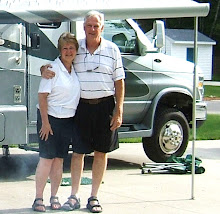







Up Rte 109 N back to Moclips Highway. We aren't really sure where our destination will be today except somewhere at the top of the northwest corner of the U.S. The highway will take us inland through the southwest tip of Olympic National Forest & Park as we begin the 400 mile plus olympic loop. The park is split into 3 sections coastline, temperate rainforest, and mountains. We will be able to experience the beauty of true wilderness. 95% of the park's 1.400 square miles is undeveloped.
Today will be a long travel day. We stopped at the Moclips Store for coffee and danish as we headed out. Traveling down the highway we could hear frogs singing and its very boggy beyond the trees. Soon we turned north on 101 and came to the Lake Quinault Recreation Area. A couple we met at the Copalis campground suggested we stop at the Lake Quinault Lodge so we followed the signs down South Shore Road winding along the glacial lake. We are now traveling through the Quinault Rainforest. Soon the lodge came into view and looked very warm, cozy, and inviting in the misty rain. We parked the coach and car in the parking lot and walked into the lodge... it's gorgeous! People had come here in the 1880's and then in 1924 the log hotel was destroyed by fire. Lodge supporters soon drew up a plan and in 53 days, on August 18, 1926, the new lodge opened. Today's lodge definitely reflects the spirit of a bygone era. We wandered around the beautiful cedar and redwood lobby. Ken found a comfy leather chair near the stone fireplace. I thought he would never get out. At the far end was a restaurant with panorama glass windows overlooking the glacial green lake. Too bad it's not time for lunch. We walked through an archway onto the large porch and down stone steps leading across the lawn to the edge of the lake. The lake and mountain views were phenominal.
Leaving the lodge we entered the Olympic National Forest and the Quinault Valley. The valley is known as the "Valley of the Giants". Here you'll find the largest Sitka Spruce tree in the world, as well as other giants of Hemlock, Douglas Fir, and Red Cedar. We are driving through parts of the Hoh Rainforest, across the Hoh River which is a beautiful glacial green and into the Olympic Wilderness. There are no towns for miles. The rainforest gets 100-plus inches of rain each year. The climate is temperate rather than tropical and feels primeval, with ferns the size of large shrubs and trees as big as skyscrapers blocking out the sunlight.
The first town we come to on what is known as the West End is Forks, Washington. For those of you who are fans of the "Twilight" book series, this will be exciting. (I haven't read them yet...). The author Stephenie Meyer is from Forks. Everything in town is Twilight - a Twilight 'location map' is included in the welcome packet for visitors so they can visit locations from the book. There are even clothing stores called "Dazzled by twilight" (Big doins!)
Further on we crossed the Sol Duc River and turned onto Rte 113 and then northwest on Rte 112 to Clallam Bay on the Strait of Juan de Fuca. Clallam Bay and it's twin town Sekiu are the fishing headquarters for the strait. Clallam Bay is on the northern most border of Washington. We are now in another climate zone where the trees are just barely budding again. Climbing through part of the Olympic Mountains the wind picked up and is blowing the coach around pretty good. We put the air bags up to 80 and it became a lot more stable. We pulled into Sam's RV Park and we're the only ones here! The park is just a little grassy field but not bad and we're only here for one night.
We got set up and then got in the car to explore. The main reason for coming to the Clallam Bay area was so we could go out to Cape Flannery. The cape is the most northwestern point in the U.S. We stopped for lunch in Sekiu at a little local restaurant overlooking the strait with the snowy mountains of Vancouver Island B.C. on the other side. We drove scenic Rte 112 W along the coast and through fantastic cedar forests. Soon we arrived at Neah Bay and the Makah Reservation where we had to buy a recreation pass. The pass supports the Makah Cultural & Recreation Museum. The Makah have lived on this rugged coast for centuries.
Leaving Neah Bay a new road took us to the Cape Flattery Trail. The 3/4 mile boardwalk and gravel trail leads down through the woods to Cape Flattery. At the end of the trail we were rewarded with views of cliffs, sea caves and breathtaking vistas of Tatoosh and Vancouver islands and the open waters of the Pacific. Sitting on a bench on the northwestern most point of the lower 48 United States where forest and sea meet we enjoyed the sounds of the waves and watched a fishing boat head out to sea. It was magnificent!
Leaving the cape we took a side road which brought us along picturesque beaches sprinkled with majestic sea stacks and rock formations. Then we headed back to camp. We drove a lot today but we saw beauty and majesty that is unparalled anywhere.
Pictures: Lake Quinault Lodge interior, Outside the lodge, Lake Quinault (2), Cape Flattery Trail, Cape Flattery View, Cape Flattery Caves & Cliffs, Tanoosh Island

No comments:
Post a Comment